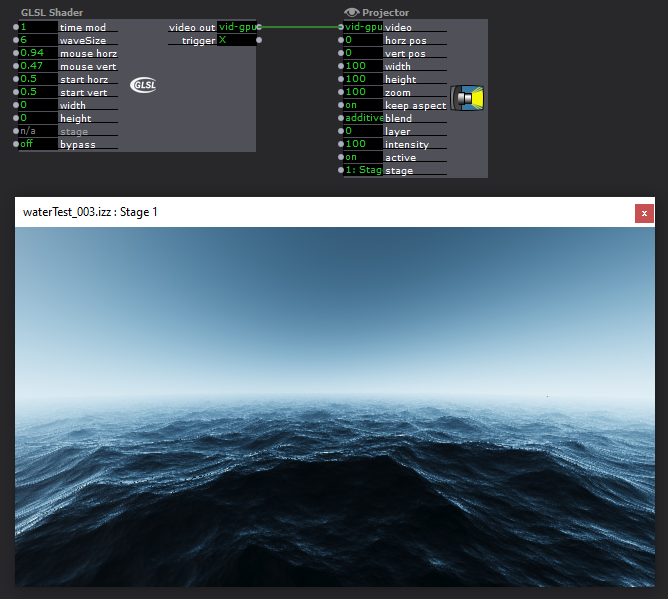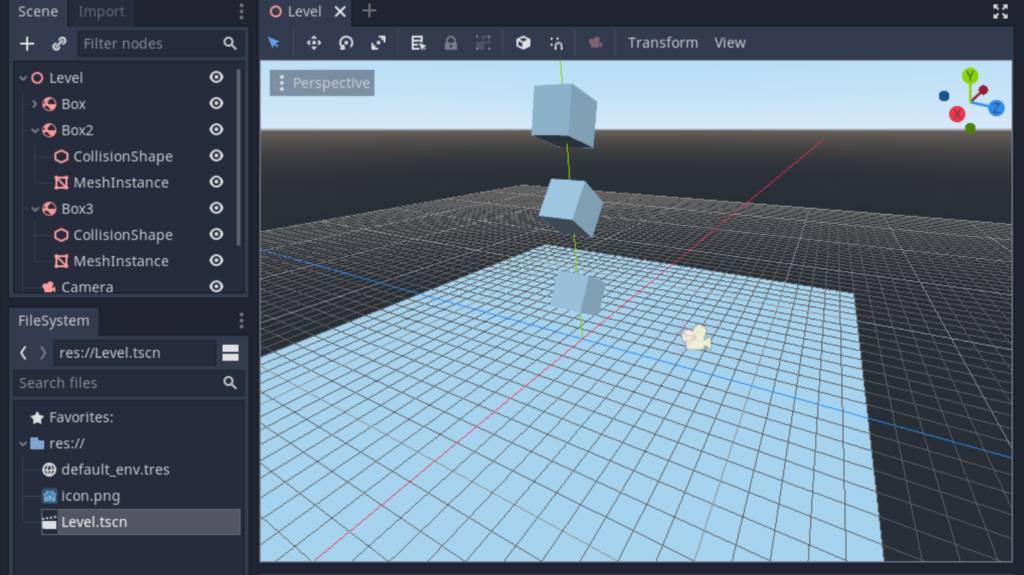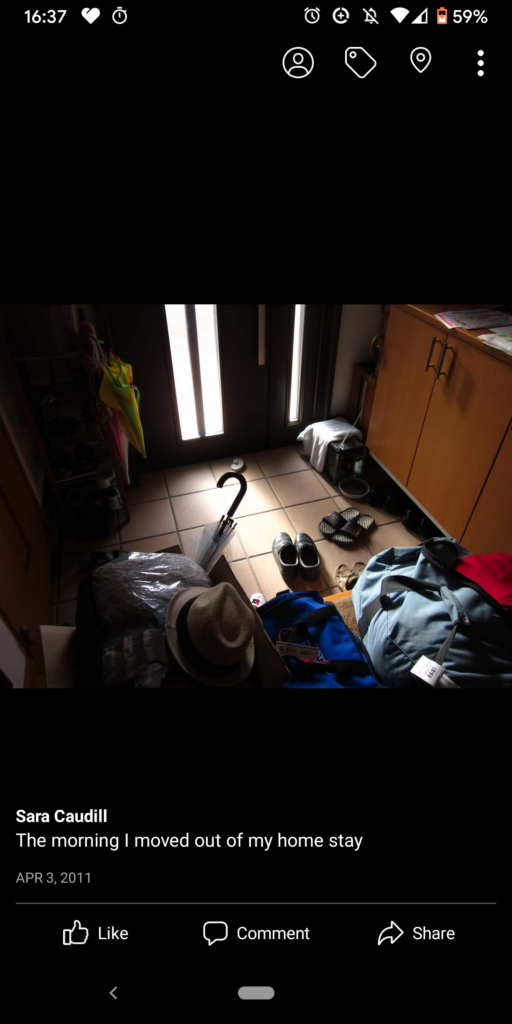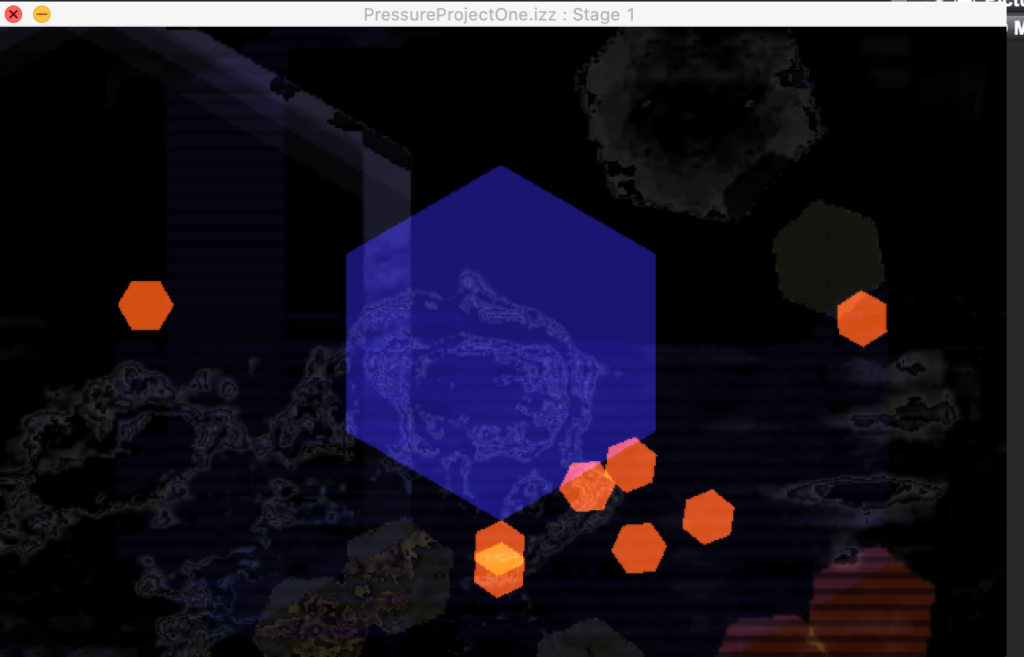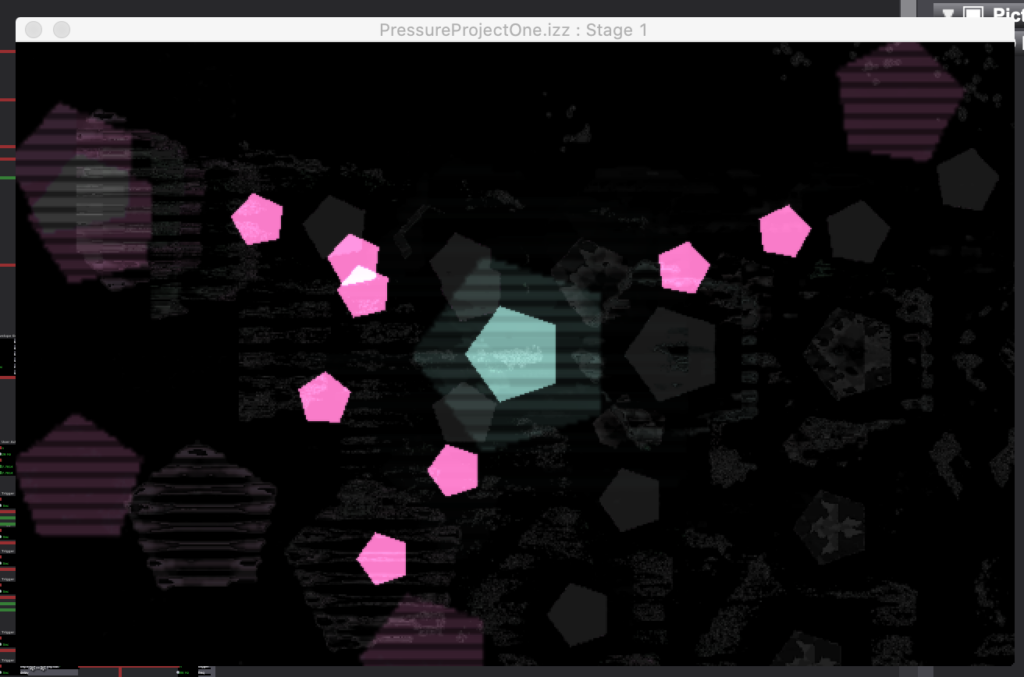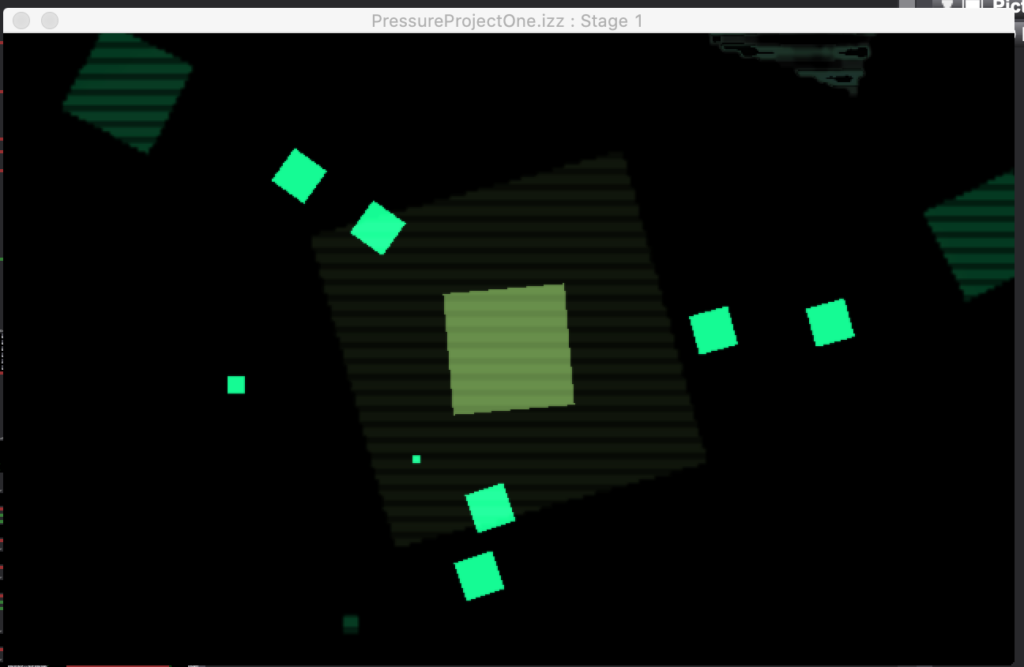Pressure Project 3
Posted: March 21, 2021 Filed under: Nick Romanowski, Pressure Project 3 | Tags: Nick Romanowski Leave a comment »For Pressure Project 3, I wanted to tell the story of creation of earth and humanity through instrumental music. One of my favorite pieces of media that has to do with the creation of earth and humanity, is a show that once ran at EPCOT at Walt Disney World. The nighttime spectacular was called Illuminations: Reflections of Earth and used music, lighting effects, pyrotechnics, and other elements to convey different acts showcasing the creation of the universe and our species.
I took this piece of music into Adobe Audition and split the track up into different pieces of music and sounds that could be manipulated or “visualized” in Isadora. My idea was to allow someone to use their hands to “conduct” or influence each act of the story as it plays our through different scenes in Isadora. The beginning of the original score is a series of crashes that get more and more rapid as time approaches the big band and kicks off the creation of the universe. Using your hands in Isadora, you become the trigger of that fiery explosion. As you bring your hands closer to one another, the crashes become more and more rapid until you put them fully together and you hear a loud crash and screech and then immediately move into the chaos of the second scene which is the fires of the creation of the universe.
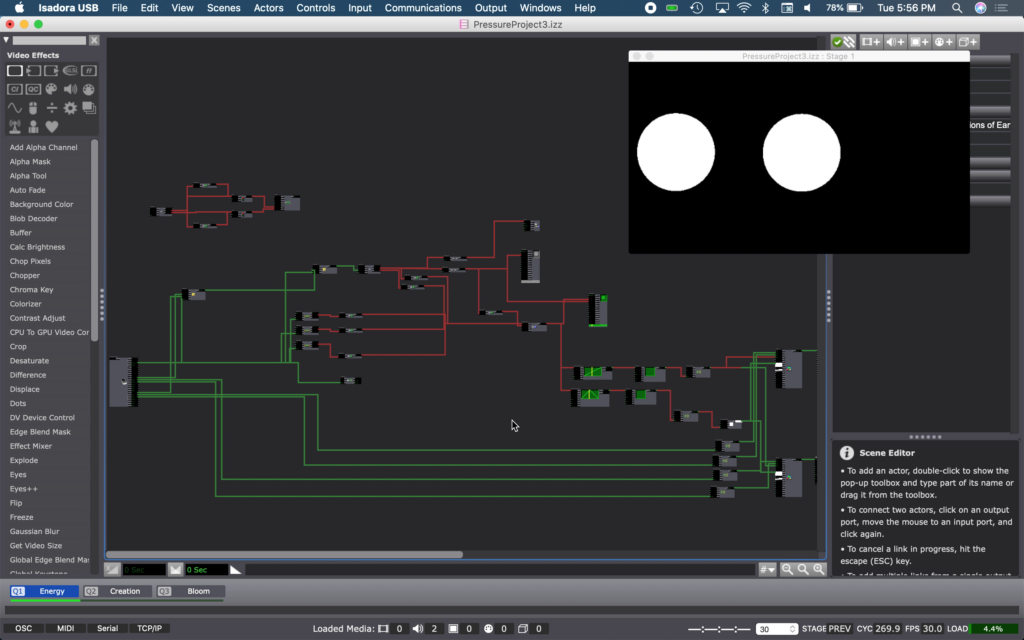
Act 2 tracks a fire ball to your hand using the Leap Motion. The flame effect is created using a GLSL shader I found on shader toy. A live-drawing actor allows a tail to follow it around. A red hue in the background flashes in sync with the music. This was an annoyingly complicated thing to accomplish. The sound frequency watcher that flashes the opacity of that color can’t listen to music within Isadora. So I had to run my audio through a movie player that outputted to something installed on my machine called Soundflower. I then set my live capture audio input to Soundflower. This little path trick allows my computer to listen to itself as if it were a mic/input.
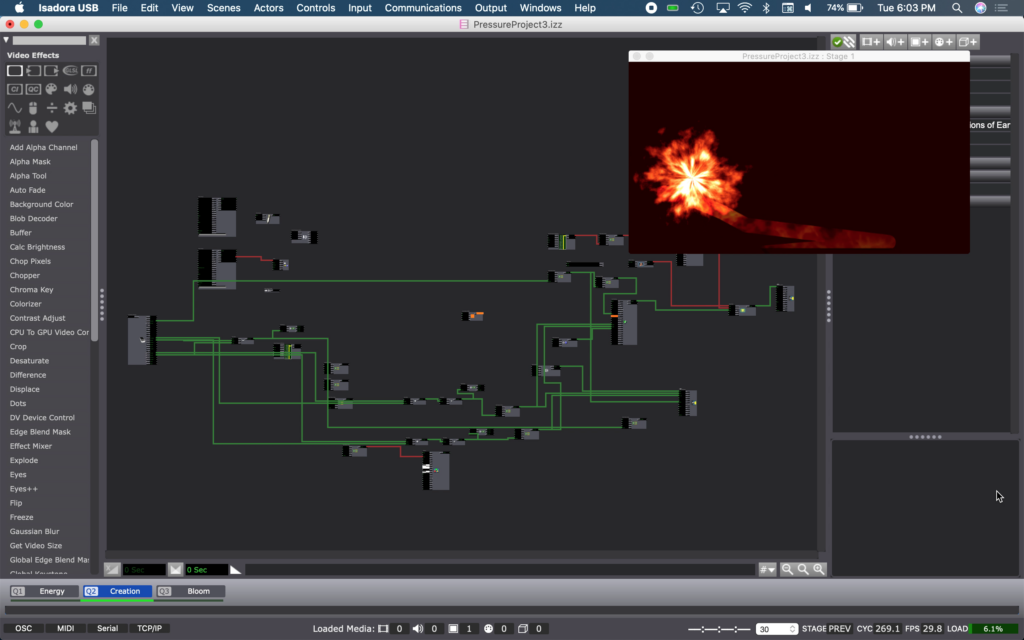
Act 3 is the calm that follows the conclusion of the flames of creation. This calm brings green to the earth as greenery and foliage takes over the planet. The tunnel effect is also a shader toy GLSL shader. Moving your hands changes how it’s positioned in frame. The colors also have opacity flashes timed with the same Soundflower effect described in Act 2.

I unfortunately ran out of time to finish the story, but I would’ve likely created a fourth and fifth act. Act 4 would’ve been the dawn of humans. Act 5 our progress as a species to today.
Pressure Project 2 (Murt)
Posted: March 20, 2021 Filed under: Uncategorized Leave a comment »For this project, I decided to work with some design elements which I did not use in PP1: set travel paths and pre-existing image assets. While I was able to get the Leap Motion functioning as I wanted it(almost), I ran out of time before I could get the trigger system set up.
I call this piece Kaiju vs. Yog-Sothoth even though two of the four available characters are American cartoon characters. The characters are: Gamera, Mothra, Reptar, and Daniel Tiger. The user is intended to select characters by moving a cursor(a six-fingered hand pointer). Each character tries to fight the Lovecraftian “Outer God” Yog-Sothoth. Only Daniel Tiger is successful. Emotional intelligence is somehow effective against Yog-Sothoth’s non-corporeal intrusion of our world.
The first of the two Isadora scenes is the character select screen which includes the Leap Motion system, shapes, and character PNGs.
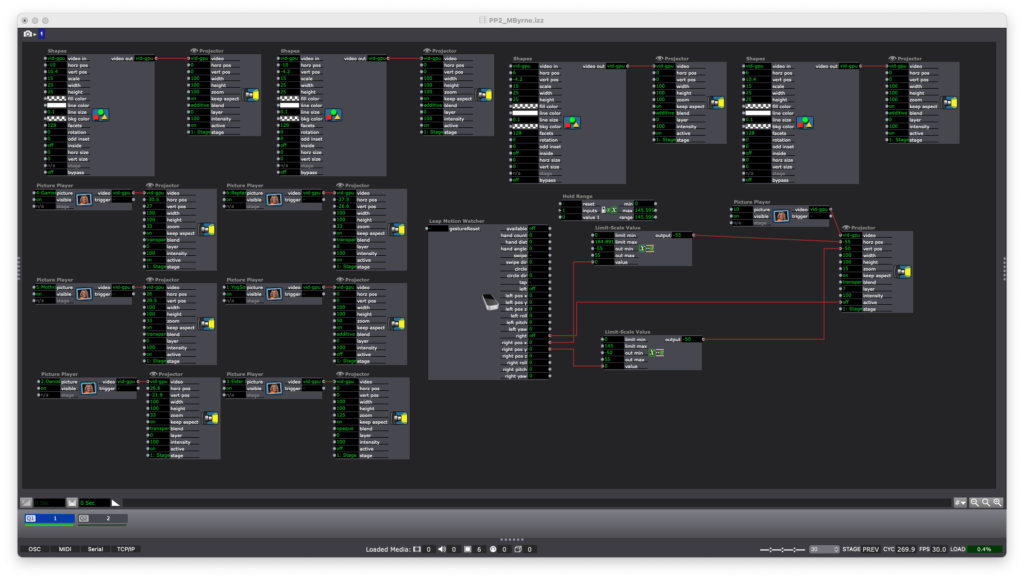
The second scene is Gamera going up against Yog-Sothoth. YS is animated with Gaussian Blur and some random waves which control X/Y dimensions. Gamera is animated in scale and path, plus a chat bubble. There is one additional animation which occurs after Gamera’s charge.

It would have been nice to see this finished, but I think what I was able to come up with is fun in itself.
Pressure Project 1 (Murt)
Posted: March 20, 2021 Filed under: Uncategorized Leave a comment »For PP1, my first area of concern was finding that moment of delight. I thought about the sorts of things that many people find delightful that also fit the resources which I possessed as a novice Isadora user. I settled on bubbles or balloons.

I created user actors for bubbles of various size, shape and color. Two of the bubbles explode and appear randomly. All of the bubbles initialize at random locations and oscillate vertically and horizontally on a sine wave. Each bubble also has random values feeding a Color Maker. The exploding bubble user actor above has an EnvGen controlling the Alpha channel. Some bubbles have their Facet value controlled by a Table to create star polygons. One of these stars has a WaveGen oscillating its Odd Inset value. I used five different scenes to cycle through the bubbles and to create an infinite sequence. I also made a control page with buttons for “GO” and “Stop”
The result is something that resembles a screen saver.
When I took Fundamentals of Media Design in the Theatre Department, one of our assignments was to move shapes around the screen using AE. This put the shapes onto a definite path, which is something I wanted to avoid with PP1. Perhaps I could have replaced one of the exploding bubbles with one which would follow a path but appear randomly.
Overall I found this project useful for learning workflows within Isadora, especially scene changes and control screens.
Pressure Project 3 (Maria)
Posted: March 12, 2021 Filed under: Maria B, Pressure Project 3, Uncategorized Leave a comment »I approached this project wanted to tell a fictional, widely recognized narrative that I knew well. So I chose to tell the story of The Lion King. My initial plan for this pressure project ended up being a lot more than I could chew in the allotted 9 hours. I wanted to bring in MIDI files that told the story through sound, and map out different notes to coordinate with the motion and color of visuals on the screen (kind of like what was demonstrated in the Isadora MIDI Madness boot-camp video). After finding MIDI versions of the Lion King songs and playing around with how to get multiple channels/instruments playing at once in Isadora, I realized that trying to map all (or even some) of these notes would be WAY too big of a task for this assignment.

At this point, I didn’t have too much time left, so I decided to take the most simple, straightforward approach. Having figured out the main moments I felt necessary to include to communicate the story, I went on YouTube and grabbed audio clips from each of those scenes. I had a lot of fun doing this because the music in this movie is so beautiful and fills me with so many memories 🙂
- Childhood
- Circle of Life
- Just can’t wait to be King
- “I laugh in the face of danger”
- Stampede
- Scene score music
- “Long live the king”
- “Run, run away and never return”
- Timone and Pumbaa
- First meet
- Hakuna Matata
- Coming Back to Pride Rock
- Nala and Simba Reunite
- Can You Feel the Love Tonight
- “simba you have to come back” “sorry no can do”
- Rafiki/omniscient Mufasa “Remember who you are”
- Simba decides to go back
- The Battle
- Score music of sad pride lands/beginning of fight
- “I killed Mufasa”
- Scar dies
- Transition music as Pride Rock becomes sunny again -> Circle of Life
I took this as an opportunity to take advantage of scenes in Isadora and made a separate scene for each audio clip. The interface for choosing the correct starting and ending points in the clip was kind of difficult, it would definitely be easier to do in Audition but this was still a good learning experience.
I used MP3 files since they act as movie files, and the movie player actor has outputs while the sound player does not. I determined the correct starting position using the ‘position’ input (and sometimes using a ‘Time to Media Percent Actor’ if I already knew exactly where in the clip I wanted to start). I connected the position output to a comparator that triggered a Jump actor to go to the next scene when the position value (value 2) went above the value I inputted (value 1).
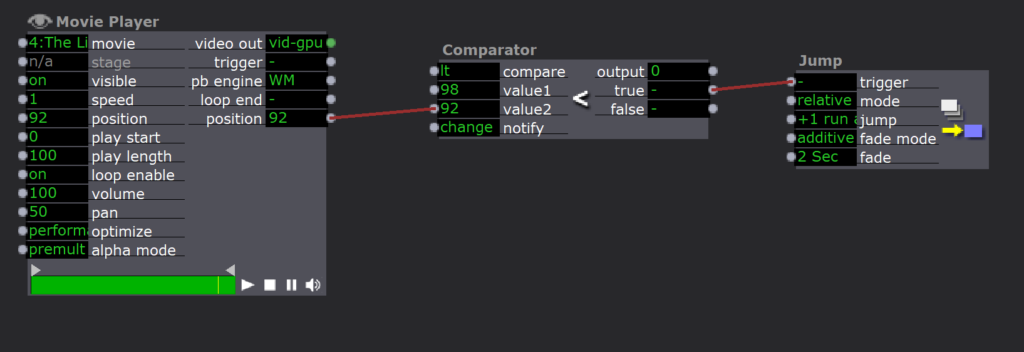
Here is the final result:
I wasn’t super proud of this at first because I didn’t feel like I took enough creative liberties with the assignment. However, when I shared it in class, it seemed to evoke an emotional response from almost everyone! It really demonstrated the power music has to bring up memories and emotions, especially when it is something so familiar. Additionally, it showed the power of a short music/audio clip to tell a story without any other context–even the people who weren’t super familiar with the movie were able to gain a general sense of the story arc.
Pressure Project 3 (Sara)
Posted: March 11, 2021 Filed under: Assignments, Pressure Project 3, Sara C Leave a comment »I plucked out the story I wanted to tell and the accompanying audio I wanted to use within half an hour of beginning. If only the remaining eight and a half hours spent on Pressure Project 3 had progressed as fluidly. Oh, well, Lawrence Halprin tells us “one of the gravest dangers we experience is the danger of becoming goal-oriented;” I don’t think anyone would accuse me of forgoing the process in favor of a goal over the course of this meandering rumination on how I’ve grappled with 3/11 in the ten years since the disaster.
First, the parts of the assignment that flowed easily:
Alex told us the deadline was Thursday, March 11. 3/11 marks the tenth anniversary of the Tōhoku earthquake and tsunami that in turn led to the Fukushima Daiichi Nuclear disaster. I was completing an undergraduate study abroad program in Shiga Prefecture at the time. As the earthquake struck and the tsunami was thundering towards the shore, I was shopping for a pencil case at a mall near Minami-Hikone Station. I was utterly oblivious to the devastation until I walked into my host family’s living room and saw a wave sweeping across airport runways.
So, yes, when Alex told us the deadline for this project was March 11, I knew there was only one “story of significant cultural relevance” I could tell.
After my study abroad program was summarily canceled, and we were forced to scramble for airfare back to the States, I spent a good deal of time adrift. Somewhere along the way, I decided I wanted to get in my car and head west. So I did. I drove west for a week, making it as far as the Badlands of South Dakota before turning around. Sometime later, I took a creative nonfiction course and wrote a piece about grappling with memories, grief, and coming unmoored. The writing was selected for my university’s literary journal, and so the audio you hear is my voice from all those years ago.
Now, onto process:
The piece was more than five minutes long, so I dumped the file into Audition and pruned it to meet Alex’s 3.5-minute requirement. Ensuring that the work still told a cohesive story after excising large swaths of it took half an hour.
After that is where things became tricky. We were told we didn’t have to use Isadora. I’ve been interested in dabbling with Godot for our upcoming Cycles project, so I was tempted to get a headstart and move directly into using the software. I jotted down the following notes:
“User plays with water while listening to audio?”
“3D water?”
Alex graciously explored GLSL shader options in Isadora with me. Unfortunately, I was 1.) stubborn and interested in Godot, and 2.) felt personally removed and emotionally remote from the visual experience. The waves were lovely, but I didn’t mold them myself. I wanted to dig my hands in the electronic clay.
I started watching Intro to Godot videos and quieted any voices in my head wondering if I was falling too far into the weeds. Four hours and fifteen minutes later, I had an amorphous blob of nothing. I wrote the following note:
“Do I press forward with Godot? Do I return to Isadora? Do I crawl back to my roots and make an animatic?”
A few months ago, I had dabbled in 3D panoramas in Photoshop using equirectangular projections. I thought that perhaps that might be a way to bring the audience closer to the story without the kitsch of “splash around in fake water with your Leap Motion while listening to young, lost Sara.” I didn’t want to Google “3/11 Triple Disaster” and sift through the wreckage like a disaster tourist, so I instead looked up photos of Lake Biwa. The school where I studied squatted right on its shore. The Google results felt inert, so I then cracked open my defunct Facebook and went back to the albums I haven’t looked at in years. I found a photo of the entryway at my homestay strewn with boxes, luggage, and shoes. The caption read: “The morning I moved out of my homestay.”
Even after all this time, it hit me like a punch to the gut. I immediately started sketching it. I didn’t know what I was actually going to do with it, but drawing was a visceral, physical relief.
After making a messy sketch, I played with palettes. Eventually, I settled on the Japanese national red as the mid-tone and bumped the lights and darks around from there. I got even messier. I wanted the colors to sort of hurt the eyes; I wanted the whole thing to feel smudgy.
All right.
I had an audio clip.
I had an illustration.
Now what?
I found more old photos. I sketched more. I emailed my host family. I cried. Eventually, I found myself with half an hour to go and disparate, disconnected images and sounds. Finally, I listened to the wind outside the trees, thought about how it sounded like waves along the shore, and jumped into Premiere to make an audio-visual composition.
I don’t really feel like I created this work so much as wrenched it loose. Truthfully, I’m grateful for the opportunity.
Pressure Project 2 (Nick)
Posted: March 2, 2021 Filed under: Nick Romanowski, Pressure Project 2 Leave a comment »I remember hearing about the LEAP motion when it was originally posted on KickStarter. One of the things that I was initially interested in was the idea of interacting with objects in virtual, 3D space. That’s the direction I head with this pressure project as I attempted to build a sort of 3D interaction interface.
I began going about this by first creating a way to visualize hands in the scene, knowing that this had to be handed off to someone I thought that forcing them to launch the LEAP visualizer would bee sort of clunky. I instead used the x and y values from each hand to generate hold values that I changed with a limit scale and fed into projectors on some images of sprite hands I found online. I used rutt etra to rotate them as well, grabbing the roll value from the LEAP and feeding it into that actor.

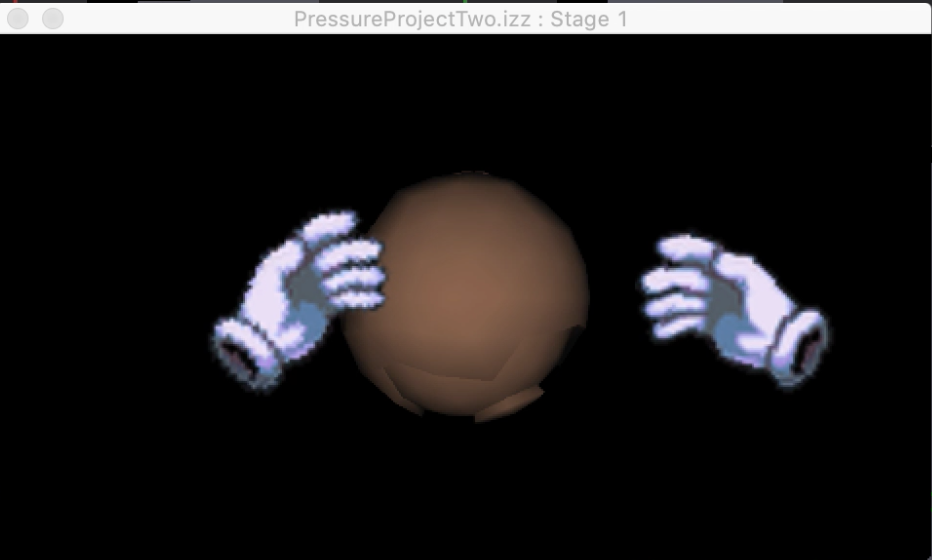
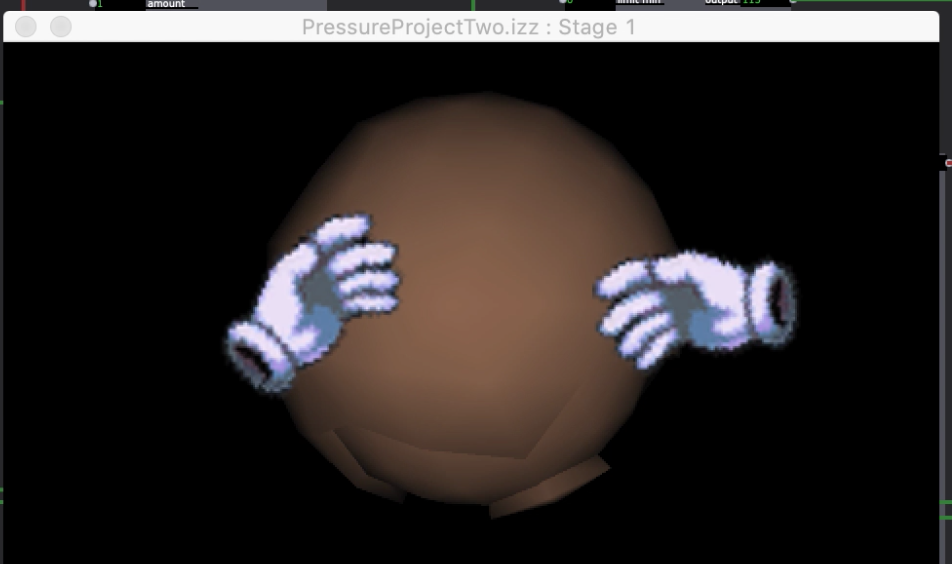
I spent a lot of time building some clunky logic gates to help make my interactions more intuitive. I wanted it to be so that if you made a circle with a finger one way, it zoomed in, but if you did it the other, it zoomed out. That required quite a bit of playing around with until I devised a system that always let the “circle” trigger through but changed whether it was adding or subtraction from the total zoom based on whether the direction was pumping out a 1 or 2. I then used a similar system to do the same thing for swiping to rotate. All of that data was plugged into a 3D player that was set to a Render which was plugged into a projector. Again, with passing this to someone else in mind, I added some quick instructions that hold on the screen until both hands are present.



Figuring out the logic gates and the 3D were probably the most difficult portions of this pressure project. In the future I think I will go with Alex’s suggestion which is to just build my logic in a javascript actor to save the trouble of using 10+ logic-esque actors passing values back and forth. I’m happy I at least got a taste of 3D as I’d like to pursue working with it further in my final project. Rutt etra was also interesting to play with as it seems to be able to take traditionally 2D objects and add a Z-axis to them, which I think will also be helpful in my final project.
Pressure Project 2 (Maria)
Posted: February 27, 2021 Filed under: Maria B, Pressure Project 2 Leave a comment »After playing around with making a ‘graphite piano’ with the Makey Makey in class, I realized how fun creating sound through unique interactions was and wanted to try it out with the Leap Motion! The basic idea was to create a piano whose notes could be played by moving your hand back and forth through the air and had accompanying visuals for each note.
At first, I attempted to do a MIDI output from Isadora to play notes through a FL Studio plugin. I’ve never done anything with MIDI before so this was extremely confusing. I decided for the sake of time and usability on other people’s devices without additional software that it would be better to just import individual audio files. At first, I downloaded mp3 files but realized that Idadora interprets these as video files, and the functionality with video files is different than with audio files on Isadora. So I converted them to WAV files and Isadora was able to recognize them as sounds 🙂
I started with programming the sounds to go with my movement with the intent to add in the visuals after. I made individual user actors for each note (see photos below) that trigger the note upon entering a certain number range. (Question: Is there a way to automate the entering of sequential numbers into a series of actors? For example if I wanted the range of the first actor to be 0-100, the next one 100-200 and so on, is there a way to do that without entering in all the values individually?)


For whatever reason Isadora did not like what I was doing and decided to crash almost every time I tried to test it 🙁 I tried to change things around by adjusting the ranges to be wider (from 50 to 100) and tried putting the sounds on separate channels and not all on one. It didn’t change too much so I decided to build out the visuals separately so they could be played without the audio if I wasn’t able to get it to work during my presentation.
Similar to the sounds, I created a user actor with inputs I could use for the visual associated with each note. They were essentially randomly colored rectangles in a line that showed up when the right hand x pos was inside a specified range and dissapeared when it wasn’t. I had some fun figuring out how to finagle this using the comparator actor plugged into the bypass input of the shape. The output of the range actor was 1 when inside the range and 0 when outside the range, so connecting it straight to the bypass would make the bypass turn ON (turning the shape off) when I was inside the range, and I needed the opposite. I was able to set the comparator to send the ON, or 1, signal to the bypass (turning the shape off) when the output from the range actor was equal to zero!
I also set it so the color would change every time the shape appeared by plugging random triggers (activated when the value exited the range) into the values of a color-maker, that connected to a gate that was opened when the value entered the range.


I then went back to experimenting with the sound to see if I could get it to work any better, and found that it didn’t freeze quite as much if I added the sound inside each shape actor.

To top off the visuals, I added a TT Gamma Actor and a TT Grid Warp Actor that were influenced by the Y position of the right hand. It gave it a cool techno feel that I realized probably would’ve aesthetically fit better with a different sounding instrument, but figured it wasn’t worth it at that point to go back and change everything.

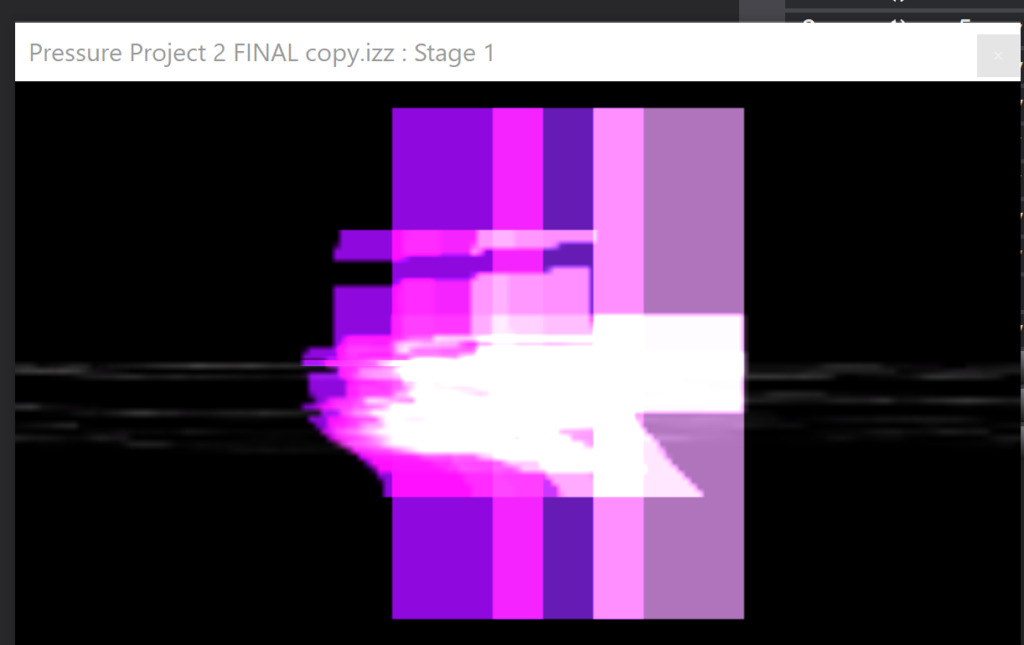
When it came to the in-class critique, there were still a few issues with crashing and Alex suggested I tried copying the scenes over into a fresh file to see if it would help. I did, and it didn’t do much, so there must just be something about the way I set up my actors that Isadora doesn’t like :/
Overall, this project got me really excited about the potential of sound in interactive experiences and has got me thinking about how I can take it further in the cycle projects!!
Pressure Project 2 (Sara)
Posted: February 23, 2021 Filed under: Assignments, Pressure Project 2, Sara C Leave a comment »After opening the project file for the first time in a week, I was mystified by how to even “read” what I had created so far. I found myself getting hot and panicky when I couldn’t get the Leap Motion to track my hand—it took me an embarrassingly long time to recall that I need to have the Leap Motion Visualizer program open at the same time while using the device.
As it turns out, I need to do a better job of documentation. Currently, my “documentation” is a mess of contextless screenshots and notes scattered across two separate notebooks I also use for my TTRPG campaigns. (Like with most things, this would not be the case Pre-Rona. Your girl is a dutiful note-taker in classroom settings. Alas.)
So, first things first, I went about bypassing, disconnecting, and reconnecting nodes to determine just what exactly everything does in my patch. Then, I commented everything out.
I’m pretty satisfied with the results. When the user twists their right wrist, lightning “shoots” out of the bottle when the angle of rotation is within established parameters. I can totally see this functionality being expanded into a sort of gamified wrist stretching exercise. “Hey, exhausted human who spends too much time at the computer! Twist your wrists to shoot the balloons out of the sky!” Perhaps that’ll be my final project if I can’t figure out how to develop a spooky Call of Cthulhu-esque Zoom UI?
Anyway, my biggest challenges with this scene entailed masking and image clipping. As the lightning activates, a low-opacity background appears. Additionally, the frame of the lightning clip is only so large, so the lightning cuts off before hitting the edge of the projector frame. When I ran into a similar issue with the bottle PNG being too small to rotate without clipping, Alex helped me add a Scaler actor. I thought the same method could both hide the sudden appearance of the background and scale out the lightning to the edge of the projector. Unfortunately, it seemed to only warp the clip. I managed to obscure the unwanted background with a dark gray square background, but I couldn’t find an answer to my lightning clipping issue.
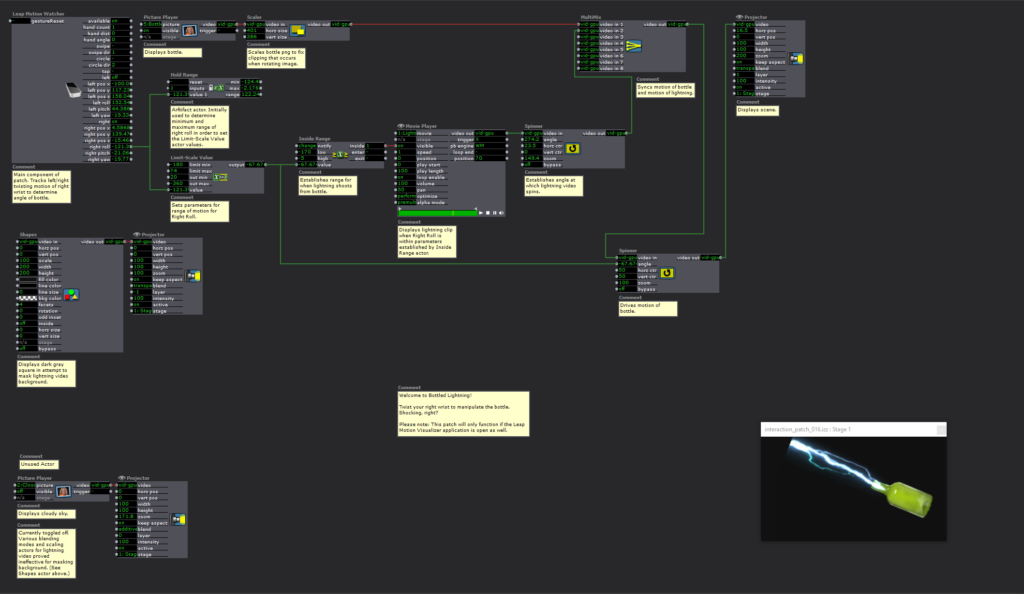
I still had quite a number of hours to go to complete the 5-hour limit for this Pressure Project, and I was fresh out of ideas for what more to do with this Bottled Lightning patch for now. I began reviewing the mishmash of screenshots I mentioned previously. Lo and behold, I stumbled upon one I named “Leap Motion Clap Color Change.” I remembered Alex and Maria puzzling through this practice patch in class, but I hadn’t yet tried it out for myself. Apologies if I totally ripped off your idea here, Maria, but I figured I had enough time to kill to try my own spin on it.
At first, I thought I’d try to do a “Clap On/Clap Off” lamp. When the hands were in range (i.e., clapping), the scene would illuminate. I even thought it might be neat to randomize the appearance of surprising/spooky/funny images.
Clap on!
“Oh, it’s a cute lil’ Shy Guy!”
Clap off!
[The lights turn off.]
Clap on!
“Ah! It’s the girl from The Ring! Clap off! Clap off!”
If you see the “TEST: Image Generator” scene in the file, you can see my attempts to sort out how to turn on and off Shy Guy.
I didn’t want to throw in the towel entirely, so I shifted to a “Clap On/Clap On” idea. In Maria and Alex’s original patch, they randomized the color of a square through a Comparator > Random > Color Maker RGBA actor sequence. Then, the same Comparator and Color Maker RGBA actors were plugged into a Gate actor that hooked up to the Shape actor. Spinning off of that, I tried to put a street light “on the fritz.” There was this unsettling path in the woods back in my William and Mary days where the lights would buzz, falter, and go out just as you happened to walk under them. I plugged the Random actor just into the blue and alpha channels to simulate that change in saturation and strength. Then, I dumped the whole thing into a shape actor, duplicated it, and scaled it down to make it look like a series of them.
In the Bottled Lightning scene, I was pleased with the Leap Motion functionality but a little vexed by the bare-bones appearance of the product. With this scene, the reverse proved true. It looked moody and evocative, but the clapping motion didn’t work as well as I would like. I’m not certain why this is the case, but I think it may have something to do with the values I input for the Inside Range actors.
Truth be told, this project felt a bit like a “sophomore slump” for me. My first project was a wacky, freeing, and free-wheeling exploration of what Isadora can do. This time around, I felt a self-imposed pressure to deliver something bigger and better. I’m still learning. I’ll keep at it and try again next time.
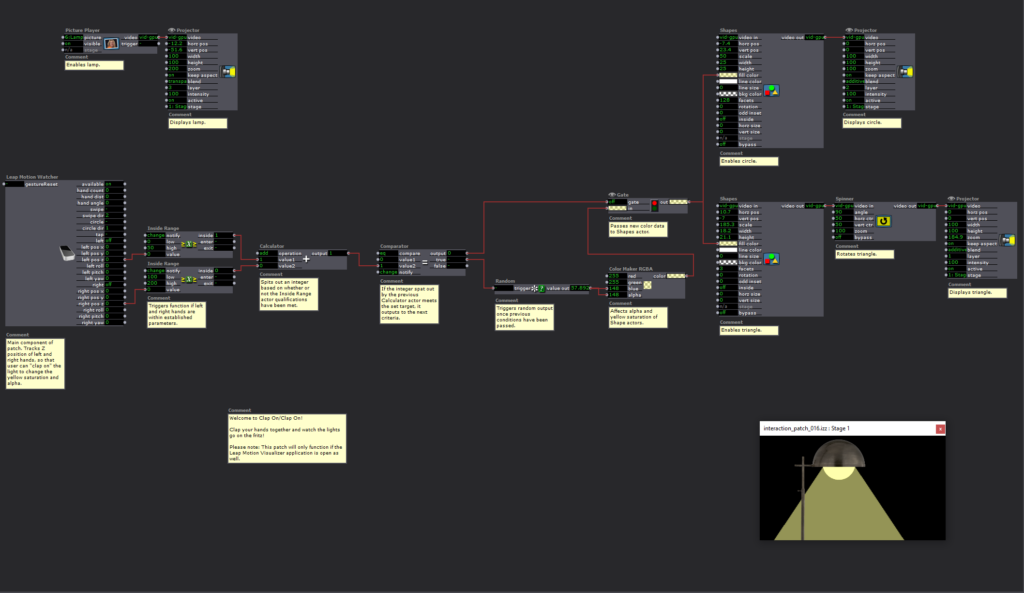
Pressure Project 1 (Nick)
Posted: February 4, 2021 Filed under: Nick Romanowski, Pressure Project I Leave a comment »With this first pressure project, I was mostly interested in playing around with Isadora and seeing what I could accomplish with the actors we’ve worked with so far and a few extra that I was able to research and play around with. I was inspired by some of the example projects we played with in the first or second week that had mesmerizing/repeating patterns.
I decided to create this sort of large “breathing” shape that would enter and exit the scene and be immediately followed by smaller versions of it that moved in a sort of orbiting fashion. Coming from a motion background, I wanted my movements to be a bit smoother than what the envelope generator offers by default. I used the curvature actors to play with the speed values the envelope generator was pumping out. To create my orbiting shapes, I created a user actor that would make one of them, and then inside there I found javascript that I could put into the javascript actor that would make them move in an elliptical motion. The user actors were built with several inputs to influence their facets (to mirror the big shape) and their motion (different values to feed into the javascript creating their circular paths). Those littler shapes were all on trigger delays to allow the mama shape to do its thing first. 20 or so seconds in, two “get stage image” actors start to capture the stage and make things even more mesmerizing. I used TT color bands and TT tv lines to create an “echo” of everything that was going on onstage and then the tv lines make it feel as if it’s sort of like a broadcast. That broadcast idea is pushed further a second “get stage image” that uses an edge detect plugged into a projector with a wave generator driving its horizontal positions, creating a sort of phasing effect. The end result is a mesmerizing, cosmic, and occasionally extraterrestrial set of visuals.

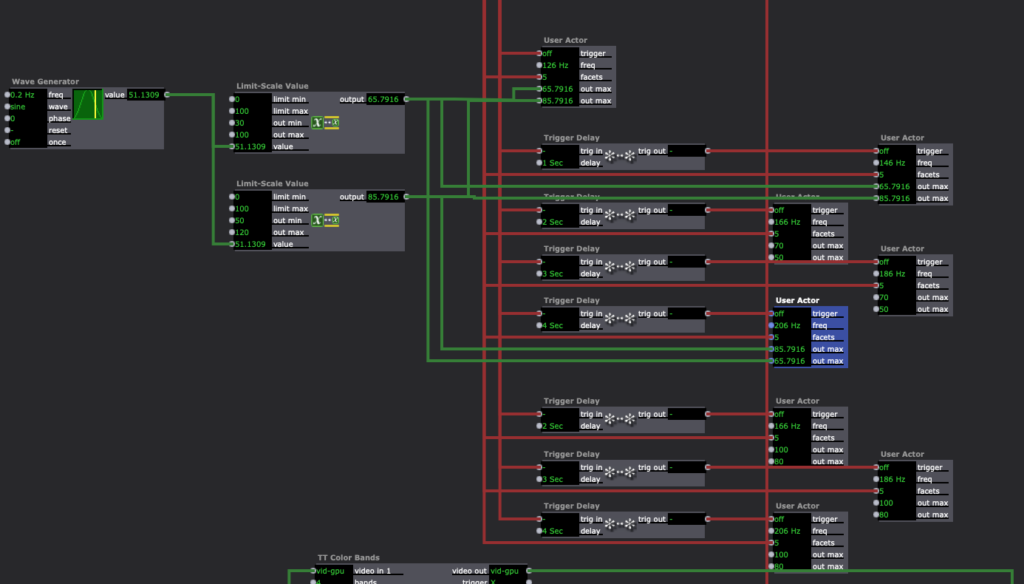
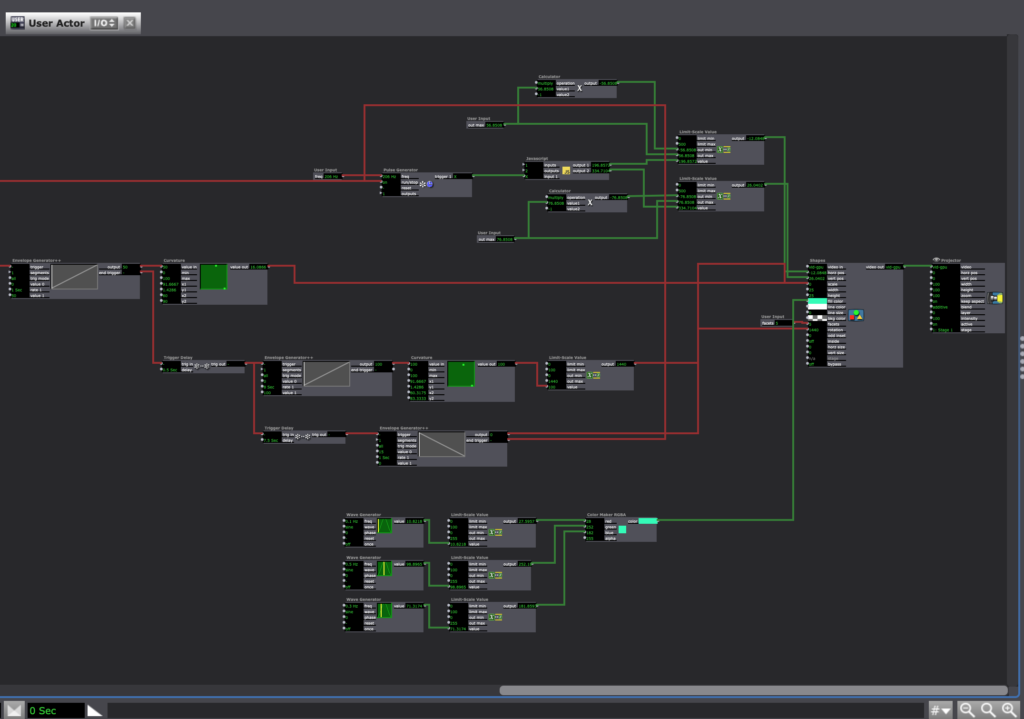

Pressure Project 1 (Maria)
Posted: February 3, 2021 Filed under: Maria B, Pressure Project I Leave a comment »I used this first pressure project to get a better feel for the different actors in Isadora and how I could manipulate them to make weird and unique visual effects. It wasn’t inspired by anything in particular, but it was interesting to hear how different classmates interpreted its meaning and its stylistic resemblance to existing works.
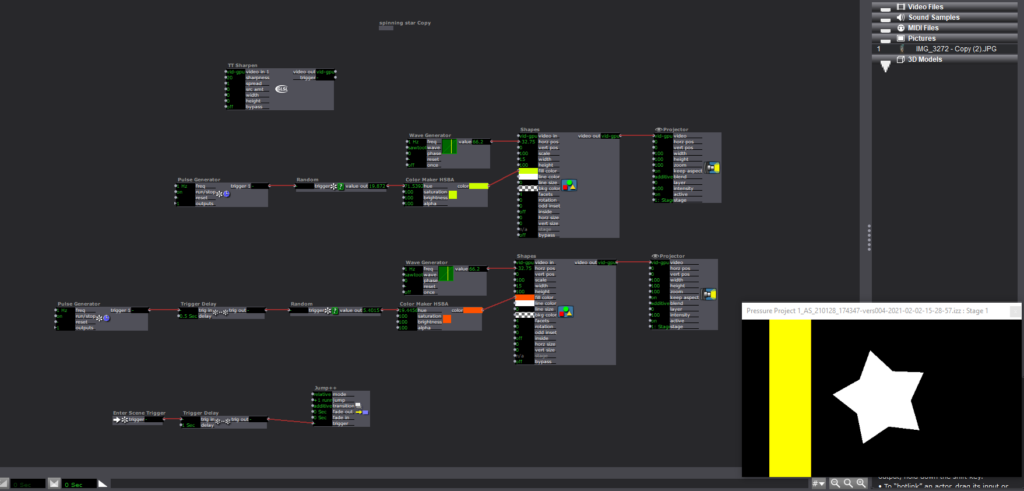
I started with a simple star shape and continued to riff off of it in subsequent scenes. I started by making it look like it was rolling by attaching a sawtooth wave generator to the star and adding rectangles moving by in the background.
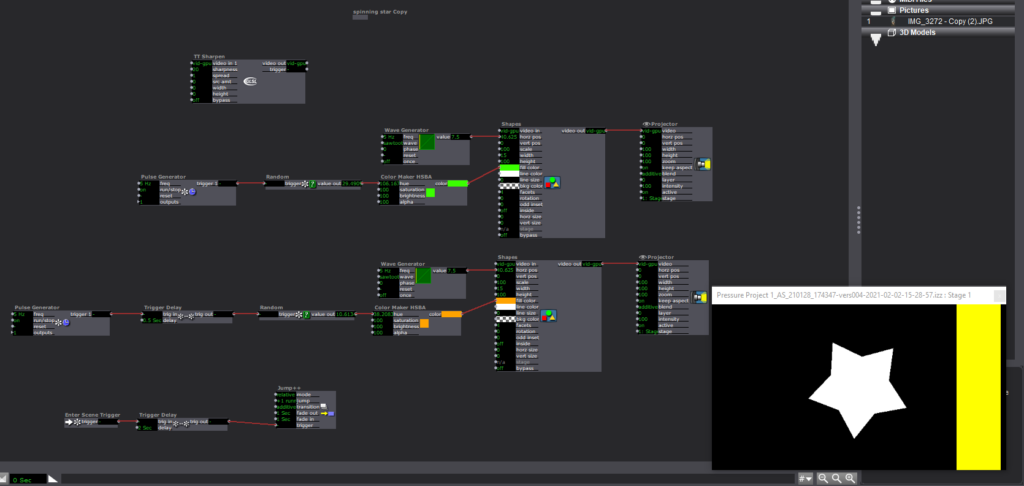
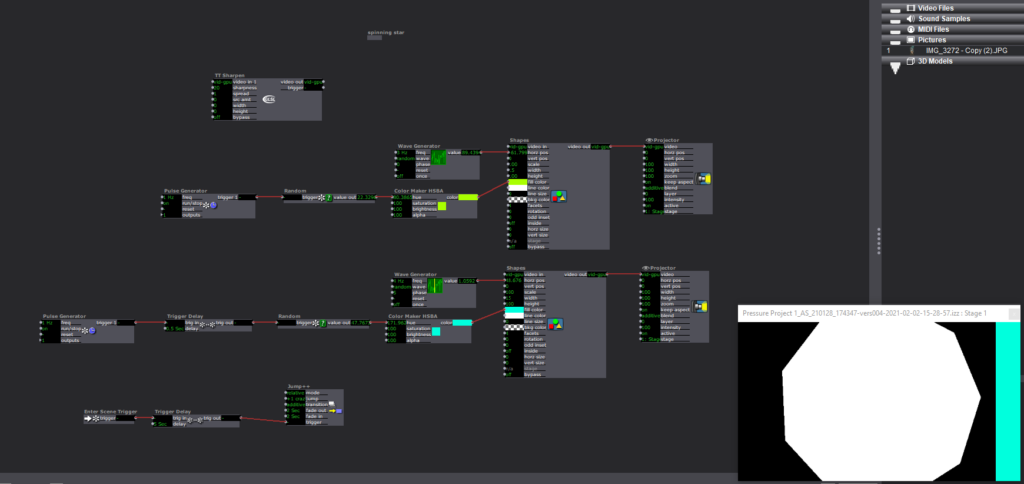
In the next scene the “plot” begins to escalate as the star moves faster and then, in the next scene, grows bigger and randomly changes # of facets (Pulse generator > random > facet input of shape actor).

In the next scene, things start to get a little trippy. I experimented with both the TT edge detect and TT sharpen (not entirely sure what happens when these two are impacted by layering them, still need to play around with it more), and tried to find ways to make the visual effects more “random.” I’m sure there are a lot of ways to do this, but the best way I knew how was to mess with the zoom of the stage, which would then alter the stage image that the Get Stage Image actor was receiving. I used a pulse generator > Random > Smoother > Limit scale value > zoom input of Projector (this was a series of actors I found myself using a lot). A common issue I had with the smoother tool was limiting the scale of the output value without making the end result choppy. Typically I’m able to fix this issue by adjusting the min and max values within an actor input/output, but for some reason I was only able to get this one to work by using the limit scale value actor.

At this point, I ditched the star and starting messing around with adding cool effects to and manipulating a photo. I zoomed into a part of a picture with some interesting texture and color and experimented with using the chroma key and the TT edge detect and sharpen actors. The goal was to create an effect similar to the demo Alex did with the fractal photo, but I couldn’t really figure out/didn’t have the time to get there. One other thing I couldn’t figure out how to do was rotate the photo, which I thought might’ve had a cool effect on the TT Edge Detect and Sharpen Actors.


In this final scene, I wanted mess around with making a bunch of little shapes moving around the scene to see how much chaos I could create. I used a lot of the same actors and series of actors as in previous scenes, but it was interesting to see how different the final result turned out.
Looking Forward
I’m really looking forward to learning more about adding in interactivity via the motion and depth sensors we got in our kits for the class. I’m excited to see what doors it will open up for potential applications for this software and how I might be able to use it (or similar software) in the future.
I also want to improve the organization and labeling within scenes, because up to this point I’ve been doing things rather haphazardly and I don’t think things are going to go too well if I continue to do this in more complex projects.
